The Puebloans, or Pueblo peoples, are Native Americans in the Southwestern United States who share common agricultural, material, and religious practices. Among the currently inhabited Pueblos, Taos, San Ildefonso, Acoma, Zuni, and Hopi are some of the best-known. Pueblo people speak languages from four different language families, and each Pueblo is further divided culturally by kinship systems and agricultural practices, although all cultivate varieties of maize.
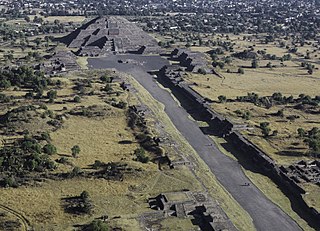
Teotihuacan is an ancient Mesoamerican city located in a sub-valley of the Valley of Mexico, which is located in the State of Mexico, 40 kilometers (25 mi) northeast of modern-day Mexico City. Teotihuacan is known today as the site of many of the most architecturally significant Mesoamerican pyramids built in the pre-Columbian Americas, namely the Pyramid of the Sun and the Pyramid of the Moon. At its zenith, perhaps in the first half of the first millennium, Teotihuacan was the largest city in the Americas, considered as the first advanced civilization on the North American continent, with a population estimated at 125,000 or more, making it at least the sixth-largest city in the world during its epoch.
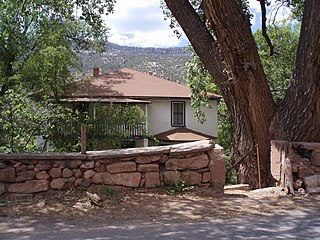
Jemez Springs is a village in Sandoval County, New Mexico, United States. The population was 250 at the 2010 census. Named for the nearby Pueblo of Jemez, the village is the site of Jemez State Monument and the headquarters of the Jemez Ranger District. The village and nearby locations in the Jemez Valley are the site of hot springs and several religious retreats.

Teotihuacán is a municipality located in the State of Mexico. The municipal seat is the town of Teotihuacán de Arista. It is in the northeast of the Valley of Mexico, 45 km northeast of Mexico City and 119 km from the state capital of Toluca. Teotihuacan takes its name from the ancient city and World Heritage site that is located next to the municipal seat. "Teotihuacan" is from Nahuatl and means "place of the gods." In Nahua mythology the sun and the moon were created here. The seal of the municipality features the Pyramid of the Sun from the archeological site, which represents the four cardinal directions. The building is tied to a character that represents water which is linked to an arm that is joined to the head of an indigenous person who is seated and speaking. This person represents a god. Much of the history of the area has been tied to the ancient city, most recently involves controversy connected with commerce and development around the site.
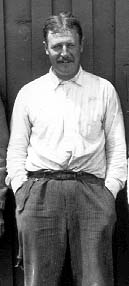
Alfred Vincent Kidder was an American archaeologist considered the foremost of the southwestern United States and Mesoamerica during the first half of the 20th century. He saw a disciplined system of archaeological techniques as a means to extend the principles of anthropology into the prehistoric past and so was the originator of the first comprehensive, systematic approach to North American archaeology.

The Temple of the Feathered Serpent is the third largest pyramid at Teotihuacan, a pre-Columbian site in central Mexico. This structure is notable partly due to the discovery in the 1980s of more than a hundred possibly sacrificial victims found buried beneath the structure. The burials, like the structure, are dated to between 150 and 200 CE. The pyramid takes its name from representations of the Mesoamerican "feathered serpent" deity which covered its sides. These are some of the earliest-known representations of the feathered serpent, often identified with the much-later Aztec god Quetzalcoatl. "Temple of the Feathered Serpent" is the modern-day name for the structure; it is also known as the Temple of Quetzalcoatl and the Feathered Serpent Pyramid.
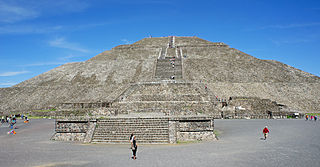
The Pyramid of the Sun is the largest building in Teotihuacan, and one of the largest in Mesoamerica. It is believed to have been constructed about 200 AD. Found along the Avenue of the Dead, in between the Pyramid of the Moon and the Ciudadela, and in the shadow of the mountain Cerro Gordo, the pyramid is part of a large complex in the heart of the city.
George L. Cowgill was an American anthropologist and archaeologist. He was a professor of anthropology at Arizona State University from 1990-2005, and research professor emeritus from 2005 until his death. He received his PhD from Harvard in 1963 with a dissertation on The Post-Classic Period in the Southern Maya Lowlands. Most of his career was devoted to research at the ancient Mexican city of Teotihuacán. He taught at Brandeis University between 1960 and 1990. Cowgill made important contributions in a number of areas, including the archaeology of Mesoamerica, the comparative study of early states and cities, and quantitative methods in archaeology.
The song "Great Green Gobs of Greasy, Grimy Gopher Guts" is a children's public domain playground song popular throughout the United States. Dating back to at least the mid-20th century, the song is sung to the tune of "The Old Gray Mare". The song, especially popular in school lunchrooms and at summer camps, presents macabre horrors through cheerful comedy while allowing children to explore taboo images and words especially as they relate to standards of cleanliness and dining. Many local and regional variations of the lyrics exist, but whatever variant, they always entail extensive use of the literary phonetic device known as an alliteration which helps to provide an amusing description of animal body parts and fluids not normally consumed by Americans.
Smithsonian Folkways is the nonprofit record label of the Smithsonian Institution. It is a part of the Smithsonian's Smithsonian Center for Folklife and Cultural Heritage, located at Capital Gallery in downtown Washington, D.C. The label was founded in 1987 after the family of Moses Asch, founder of Folkways Records, donated the entire Folkways Records label to the Smithsonian. The donation was made on the condition that the Institution continue Asch's policy that each of the more than 2,000 albums of Folkways Records remain in print forever, regardless of sales. Since then, the label has expanded on Asch's vision of documenting the sounds of the world, adding six other record labels to the collection, as well as releasing over 300 new recordings. Some well-known artists have contributed to the Smithsonian Folkways collection, including Pete Seeger, Ella Jenkins, Woody Guthrie, and Lead Belly. Famous songs include "This Land Is Your Land", "Goodnight, Irene", and "Midnight Special". Due to the unique nature of its recordings, which include an extensive collection of traditional American music, children's music, and international music, Smithsonian Folkways has become an important collection to the musical community, especially to ethnomusicologists, who utilize the recordings of "people's music" from all over the world.
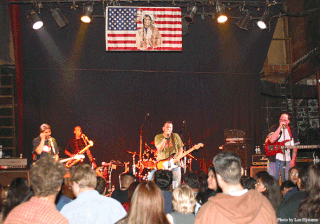
Red Earth is an American rock band from Albuquerque, New Mexico which has released three independent albums.
Marc Herring is an American media executive and communications consultant. He is founder and CEO of Herring Media Group, a USA-UK based consultancy advising global clients in the design and implementation of contemporary media networks, advanced digital communications platforms and capital projects. The firm is developing augmented and interactive assets with intelligent analytics and programmatic media delivery.

Gertrude Prokosch Kurath (1903–1992) was an American dancer, researcher, author, and ethnomusicologist. She researched and wrote extensively on the study of dance, co-authoring several books and writing hundreds of articles. Her main areas of interest were ethnomusicology and dance ethnology, with some of her best known works being "Panorama of Dance Ethnology" in Current Anthropology (1960), the book Music and dance of the Tewa Pueblos co-written with Antonio Garcia (1970), and Iroquois Music and Dance: ceremonial arts of two Seneca Longhouses (1964), in the Smithsonian Institution Bureau of American Ethnology bulletin. She made substantial contributions to the study of Amerindian dance, and to dance theory. From 1958 to January 1972 she was dance editor for the journal Ethnomusicology.

The pre-Columbian history of the territory now making up the country of Mexico is known through the work of archaeologists and epigraphers, and through the accounts of Spanish conquistadores, settlers and clergymen as well as the indigenous chroniclers of the immediate post-conquest period.
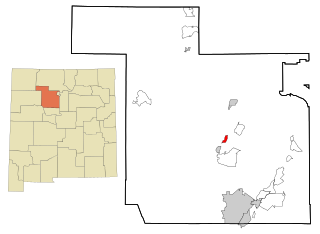
Jemez Pueblo is a census-designated place (CDP) in Sandoval County, New Mexico, United States. The population was 1,788 at the 2010 census. It is part of the Albuquerque Metropolitan Statistical Area.
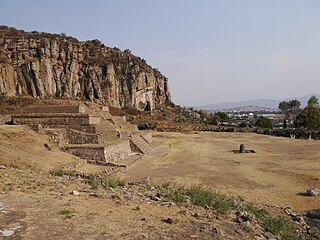
Huapalcalco is a pre-Columbian Mesoamerican archeological site located some 5 kilometers north of Tulancingo in the state of Hidalgo, Mexico.
Folkways Records was a record label founded by Moses Asch that documented folk, world, and children's music. It was acquired by the Smithsonian Institution in 1987 and is now part of Smithsonian Folkways.

Barton McLean is an American composer, performer, music reviewer, and writer.

New Mexico music is a genre of music that originated in the US state of New Mexico, it derives from Pueblo music in the 13th century, and with the folk music of Hispanos during the 16th to 19th centuries in Santa Fe de Nuevo México.

Astialakwa was a prehistoric and historic village built by the ancestral Puebloan people located within the Astialakwa Archeological District, in an area now known as the Jemez Springs area of Northern New Mexico. The archeological area is on the National Register of Historic Places. The location is restricted from access.














